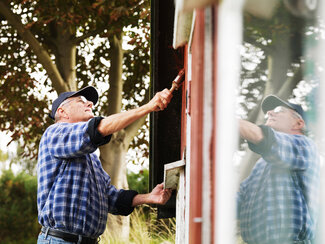As a savvy homeowner, you know that repainting your home’s exterior not only boosts its curb appeal but also protects it from the ravages of weather. But for the best results, choosing the right time and temperature to paint outside is crucial. This guide will enumerate the factors that affect how paint dries and adheres to surfaces and provide tips to ensure your next outdoor painting project succeeds.
The Importance of Temperature and Weather Conditions
Temperature, humidity, and wind are the three main weather factors that influence the drying and adhesion of paint. When the temperature is too low, the paint will not dry properly, leading to poor adhesion and a higher likelihood of cracking and peeling. On the other hand, when it is too hot, the paint can dry too quickly, making it challenging to apply evenly and potentially leading to brush marks or an uneven finish.
Humidity plays a critical role as well. High humidity can prolong the drying time, while low humidity can cause the paint to dry too quickly. Wind, meanwhile, can cause debris to stick to the wet paint or force the paint to dry too fast, leading to an uneven finish.
Ideal Temperature Range for Exterior Painting
Most paint manufacturers recommend a temperature range of 10 to 29 degrees Celsius (or 50-80 degrees Fahrenheit) for optimal paint application and drying. However, it is crucial to check the label of the specific paint you are using, as some paints may have unique temperature requirements.
Also, specially formulated paints are available for painting in colder temperatures, typically down to 35 degrees Fahrenheit (2 degrees Celsius). These paints contain additives that help them dry and adhere properly, even in less-than-ideal conditions.
Tips for Painting in the Right Temperature and Weather Conditions
- Check the forecast: Before you start an outdoor painting project, check the weather forecast for the next few days. Look for days with temperatures within the recommended range and relatively low humidity. Avoid this task if rain or high winds are expected, as these conditions can hinder the paint’s ability to dry and adhere properly.
- Mind the temperature fluctuations: The temperature can vary significantly throughout the day. Try to paint during the warmest part of the day, and avoid this job in direct sunlight because this can cause the paint to dry too fast. If you must paint in cooler temperatures, use cold-weather paint formulated for lower temperatures.
- Monitor humidity levels: High humidity can prolong the drying time of paint, so it is best to paint on days with moderate humidity levels. If you must paint on a humid day, try to start early or late in the afternoon, when humidity levels are typically lower.
- Choose the right paint: As mentioned earlier, some paints are formulated specifically for use in colder temperatures. If you need to paint in cooler weather, look for a paint designed for this purpose, and always follow the manufacturer’s recommendations for application and drying times.
- Test a small area: Before you begin painting the entire surface, it is a good idea to test a small, inconspicuous area to ensure the paint will dry and adhere properly. It will help determine if the temperature and weather suit your painting project.
Conclusion
Finding the right temperature and weather conditions for exterior painting is crucial for achieving a lasting, professional-looking finish. By following these tips and paying close attention to the specific requirements of your paint, you can ensure your next outdoor painting project is a success.
Are you in need of a reliable and experienced painter in Victoria, BC? Look no further than Amira’s Painting Ltd.! Our team of skilled painters has over a decade of experience and will provide you with exceptional quality workmanship and attention to detail. Contact us today for a quote!

